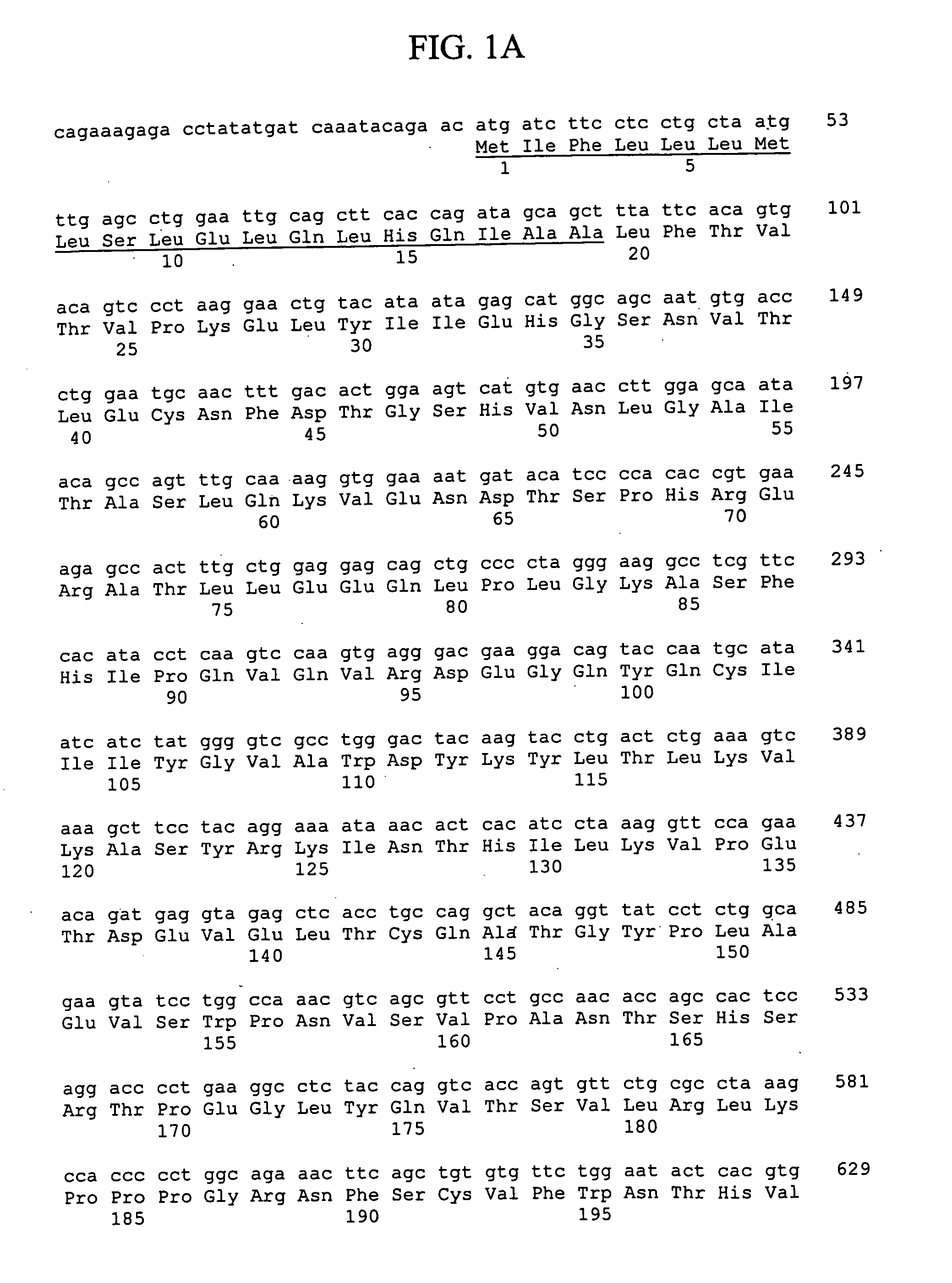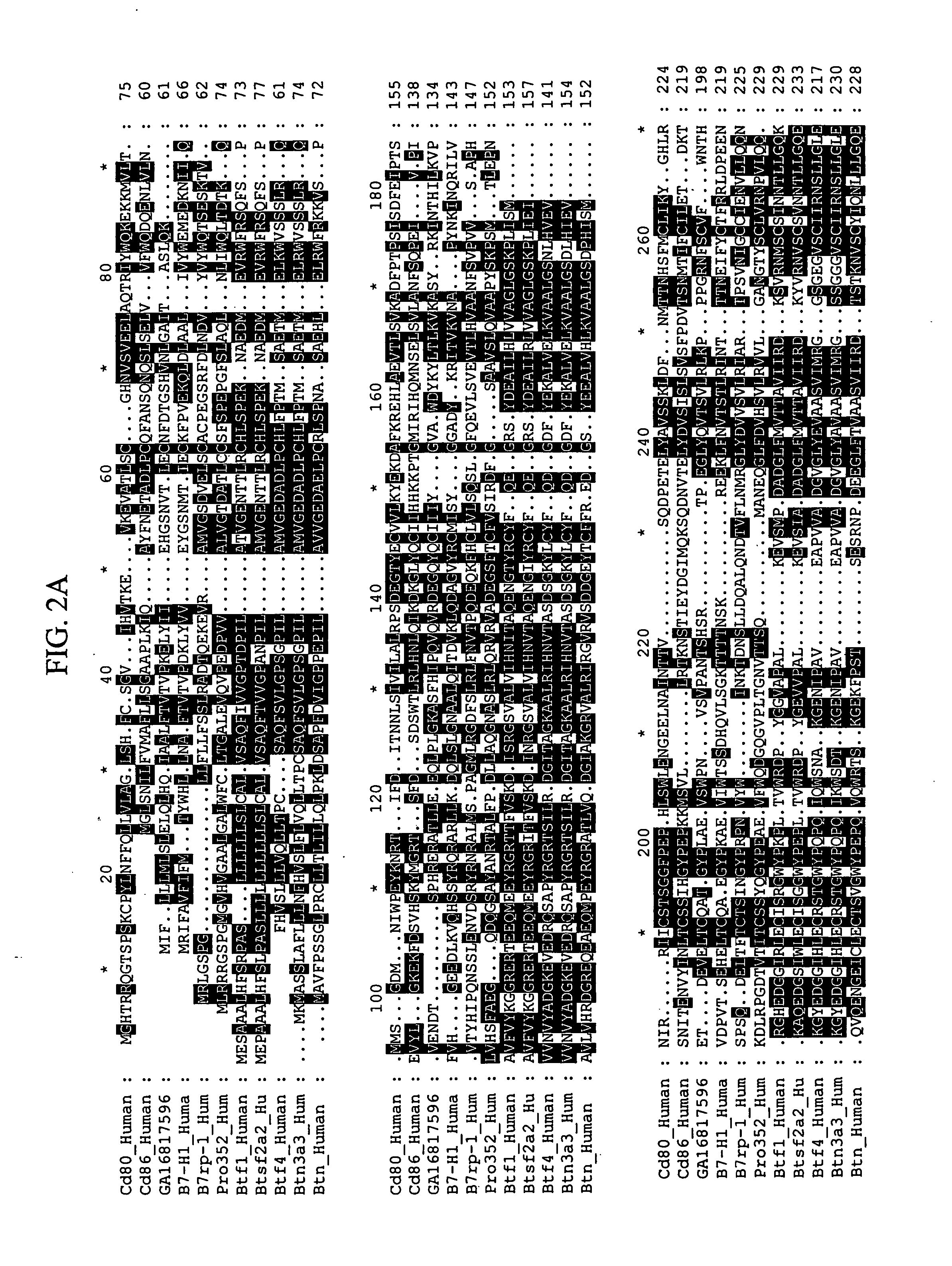B7-like molecules and uses thereof
a technology of b7-like molecules and nucleic acids, applied in the field of b7-like (b7l) polypeptides and nucleic acid molecules, can solve the problem that the potential for the development of novel therapeutics based on the human genome is still largely unrealized
- Summary
- Abstract
- Description
- Claims
- Application Information
AI Technical Summary
Benefits of technology
Problems solved by technology
Method used
Image
Examples
example 1
Cloning of the Human B7-L Polypeptide Genes
[0336] Generally, materials and methods as described in Sambrook et al. supra were used to clone and analyze the genes encoding human and murine B7-L polypeptides.
[0337] A search of the Genbank-EMBL database was performed using the TBLASTX program (http: / / blast.wustl.edu) and B7-H1 as the query sequence. A human genomic clone (Celera Genomics, Rockville, Md., GA—16817596) was identified as containing nucleic acid sequence encoding a putative new member of the B7 family. The predicted cDNA sequence for this putative new member of the B7 family was assembled using a clone containing a partial B7-L nucleic acid sequence (GenBank accession no. AK001872).
[0338] Plasmid DNA from various cDNA libraries and Marathon cDNA libraries (Clontech, Palo Alto, Calif.) was used as a template in PCR amplifications performed with the primers 2515-27 (5′-C-A-T-A-A-T-A-G-A-G-C-A-T-G-G-C-A-G-C-A-A-T-G-T-G-A-C-3′; SEQ ID NO: 26) and 2524-63 (5′-G-G-G-T-C-C-T-G...
example 2
B7-L mRNA Expression
[0347] A multiple human tissue Northern blot (Clontech) was hybridized to an 874 bp probe corresponding to nucleotides 33-906 of the human B7-L cDNA sequence. The probe was radioactively labeled using a Prime-It RmT Random Primer Labeling kit (Stratagene) according to the manufacturer's instructions. Northern blots were hybridized and washed according to the manufacturer's instructions, and then exposed to autoradiography. FIG. 8 illustrates the results of the Northern blot analysis.
[0348] The expression of B7-L mRNA is localized by in situ hybridization. A panel of normal embryonic and adult mouse tissues is fixed in 4% paraformaldehyde, embedded in paraffin, and sectioned at 5 μm. Sectioned tissues are permeabilized in 0.2 M HCl, digested with Proteinase K, and acetylated with triethanolamine and acetic anhydride. Sections are prehybridized for 1 hour at 60° C. in hybridization solution (300 mM NaCl, 20 mM Tris-HCl, pH 8.0, 5 mM EDTA, 1× Denhardt's solution, ...
example 3
Production of B7-L Polypeptides
A. Expression of B7-L Polypeptides in Bacteria
[0350] PCR is used to amplify template DNA sequences encoding a B7-L polypeptide using primers corresponding to the 5′ and 3′ ends of the sequence. The amplified DNA products may be modified to contain restriction enzyme sites to allow for insertion into expression vectors. PCR products are gel purified and inserted into expression vectors using standard recombinant DNA methodology. An exemplary vector, such as pAMG21 (ATCC no. 98113) containing the lux promoter and a gene encoding kanamycin resistance is digested with Bam HI and Nde I for directional cloning of inserted DNA. The ligated mixture is transformed into an E. coli host strain by electroporation and transformants are selected for kanamycin resistance. Plasmid DNA from selected colonies is isolated and subjected to DNA sequencing to confirm the presence of the insert.
[0351] Transformed host cells are incubated in 2×YT medium containing 30 μg / m...
PUM
| Property | Measurement | Unit |
|---|---|---|
| melting temperature | aaaaa | aaaaa |
| melting temperature | aaaaa | aaaaa |
| temperature | aaaaa | aaaaa |
Abstract
Description
Claims
Application Information
 Login to view more
Login to view more - R&D Engineer
- R&D Manager
- IP Professional
- Industry Leading Data Capabilities
- Powerful AI technology
- Patent DNA Extraction
Browse by: Latest US Patents, China's latest patents, Technical Efficacy Thesaurus, Application Domain, Technology Topic.
© 2024 PatSnap. All rights reserved.Legal|Privacy policy|Modern Slavery Act Transparency Statement|Sitemap



